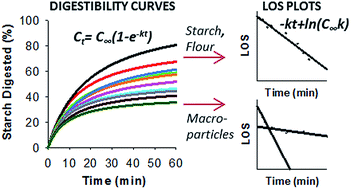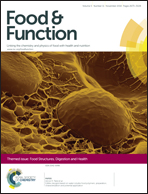A novel method for classifying starch digestion by modelling the amylolysis of plant foods using first-order enzyme kinetic principles
Abstract
Studying starch amylolysis kinetics in vitro is valuable for predicting the postprandial glycaemic response to starch intake. Prediction of starch amylolysis behaviour is challenging however, because of the many physico-chemical factors which influence amylolysis. The Logarithm of Slope (LOS) method for analysis of digestibility curves using first-order enzyme kinetics can identify and quantify nutritionally important starch fractions. The early stages of in vitro amylolysis of hydrothermally processed chickpea and durum wheat with variable degrees of structural integrity were studied. The end-point product concentration (C∞) and the pseudo first-order digestibility rate constant k, obtained from LOS analysis, were then used to compute predictive digestibility curves for evaluation of the model performance. LOS analysis enabled rapid identification of nutritionally important starch-fractions. It was clear that purified starches and flours were digested by a single-phase process, but starch amylolysis in macroparticles occurred by a two-phase system that reflected differences in substrate accessibility. The model gave an excellent fit to data obtained from a range of heterogeneous materials. It provides a rigorous means of studying the mechanisms of starch amylolysis in samples of varying complexity, and we strongly recommend its use for the rapid and accurate predictions of amylolysis. Such predictions have implications for prevention and management of type 2 diabetes mellitus and obesity.

- This article is part of the themed collection: Food Structures, Digestion and Health International Conference

 Please wait while we load your content...
Please wait while we load your content...